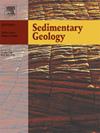末次盛冰期以来珠江边缘陆源沉积物输入的海平面控制
IF 2.9
2区 地球科学
Q1 GEOLOGY
引用次数: 0
摘要
末次盛冰期(LGM)以来的冰川-上升海平面变化经常被认为是陆源输入到边缘海盆地深水环境的主要驱动因素。然而,在陆架边缘位于水深超过120米的大陆边缘,自LGM以来的海平面上升变化是否以及如何控制了陆源沉积物进入深水仍然是一个相当有趣的话题。以平均水深为250 m的陆架边缘珠江边缘为研究区,利用海底峡谷头口两个活塞岩心的沉积记录,重建了LGM以来陆源深水输入的历史。然后,我们将陆源输入的变化与当代海平面上升变化联系起来,以研究海平面变化对陆源输入的作用的细节。结果表明,珠江边缘陆源深水输入经历了3个阶段的时间演化。在冰期、冰期和间冰期,陆源输入分别为高、减少和低,与海平面低水位、海平面上升和海平面高水位具有良好的相关性。这种紧密耦合强烈表明,自LGM以来,冰川-海平面上升的变化仍然可以控制珠江边缘陆源深水的输入。具体而言,在LGM之后,第一次海平面快速上升发生在Heinrich Stadial 1 (HS1)和b ølling- allero ød (B-A)时期,海平面急剧上升淹没了陆架,使海岸线向陆地移动,从而导致陆源输入在千年尺度上下降。在间冰期,海平面几乎上升到现在的水平,并保持相对稳定,在此期间,东亚季风的波动可能对陆源输入产生影响。因此,在间冰期,陆源输入虽然普遍较低,但与季风气候的变化有轻微的波动。这项研究加深了我们对海平面变化在沉积物扩散系统中的基本作用的认识,并为理解深海动力学提供了意义,特别是在大陆架边缘处于更大水深和气候条件迅速变化的大陆边缘的背景下。本文章由计算机程序翻译,如有差异,请以英文原文为准。
Sea-level controls on terrigenous sediment input to deep water of the Pearl River margin since the last glacial maximum
Glacio-eustatic sea-level changes since the Last Glacial Maximum (LGM) have been frequently regarded as the primary driver of terrigenous input to deep-water settings of marginal sea basins. However, on those continental margins where shelf edges lie at water depths farther exceeding 120 m, whether and how eustatic sea-level changes since the LGM have controlled terrigenous sediment input to deep water remains a topic of considerable interest. Taking the Pearl River margin that has a shelf edge with average water depth of 250 m as the study area, we use the depositional records of two piston cores on the head and mouth of a submarine canyon to reconstruct the history of terrigenous input to deep water since the LGM. We then relate the variations of terrigenous input to the contemporary eustatic sea-level changes to examine the details of the role of sea-level changes on terrigenous input. The results indicate that since the LGM there was a three-stage temporal evolution of terrigenous input to deep water on the Pearl River margin. During glacial, deglacial, and interglacial periods, terrigenous input were respectively high, decreasing, and low, correlating well with sea-level lowstands, sea-level rising, and sea-level highstands. Such tight coupling strongly suggests that glacio-eustatic sea-level changes since the LGM could still control terrigenous input to deep water on the Pearl River margin. Specifically, after the LGM, the first rapid sea-level rise, occurred in the periods of Heinrich Stadial 1 (HS1) and Bølling-Allerød (B-A), dramatically inundated the shelf, shifted the shoreline landward and thus, caused a millennial-scale drop of terrigenous input. Within the interglacial period, the sea level had risen almost to its present level and remained relatively stable, during which fluctuations in East Asian Monsoon (EAM) might have an influence on terrigenous input. Therefore, within the interglacial period, terrigenous input, though generally having low levels, showed a slight fluctuation correlated well with the changes of monsoonal climates. This study deepens our knowledge on the fundamental role of sea-level changes in sediment dispersal systems and provides implications for understanding deep-sea dynamics, especially within the context of a continental margin where shelf edges are found at much greater water depths and climatic conditions are rapidly changing.
求助全文
通过发布文献求助,成功后即可免费获取论文全文。
去求助
来源期刊

Sedimentary Geology
地学-地质学
CiteScore
5.10
自引率
7.10%
发文量
133
审稿时长
32 days
期刊介绍:
Sedimentary Geology is a journal that rapidly publishes high quality, original research and review papers that cover all aspects of sediments and sedimentary rocks at all spatial and temporal scales. Submitted papers must make a significant contribution to the field of study and must place the research in a broad context, so that it is of interest to the diverse, international readership of the journal. Papers that are largely descriptive in nature, of limited scope or local geographical significance, or based on limited data will not be considered for publication.
 求助内容:
求助内容: 应助结果提醒方式:
应助结果提醒方式:


